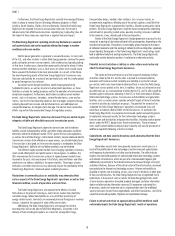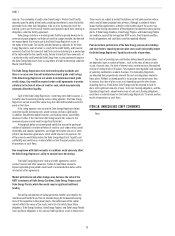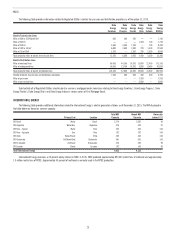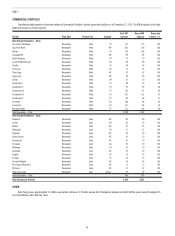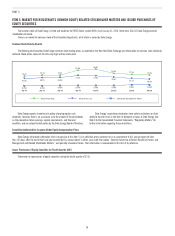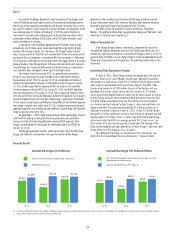Duke Energy 2015 Annual Report Download - page 40
Download and view the complete annual report
Please find page 40 of the 2015 Duke Energy annual report below. You can navigate through the pages in the report by either clicking on the pages listed below, or by using the keyword search tool below to find specific information within the annual report.
PART I
20
industry. The availability of credit under Duke Energy’s Master Credit Facility
depends upon the ability of the banks providing commitments under the facility
to provide funds when their obligations to do so arise. Systematic risk of the
banking system and the financial markets could prevent a bank from meeting its
obligations under the facility agreement.
Duke Energy maintains a revolving credit facility to provide backup for its
commercial paper program and letters of credit to support variable rate demand
tax-exempt bonds that may be put to the Duke Energy Registrant issuer at
the option of the holder. The facility includes borrowing sublimits for the Duke
Energy Registrants, each of whom is a party to the credit facility, and financial
covenants that limit the amount of debt that can be outstanding as a percentage
of the total capital for the specific entity. Failure to maintain these covenants at
a particular entity could preclude Duke Energy from issuing commercial paper or
the Duke Energy Registrants from issuing letters of credit or borrowing under the
Master Credit Facility.
The Duke Energy Registrants must meet credit quality standards and
there is no assurance they will maintain investment grade credit ratings.
If the Duke Energy Registrants are unable to maintain investment grade
credit ratings, they would be required under credit agreements to provide
collateral in the form of letters of credit or cash, which may materially
adversely affect their liquidity.
Each of the Duke Energy Registrants’ senior long-term debt issuances is
currently rated investment grade by various rating agencies. The Duke Energy
Registrants cannot ensure their senior long-term debt will be rated investment
grade in the future.
If the rating agencies were to rate the Duke Energy Registrants below
investment grade, borrowing costs would increase, perhaps significantly.
In addition, the potential pool of investors and funding sources would likely
decrease. Further, if the short-term debt rating were to fall, access to the
commercial paper market could be significantly limited.
A downgrade below investment grade could also require the posting of
additional collateral in the form of letters of credit or cash under various credit,
commodity and capacity agreements and trigger termination clauses in some
interest rate derivative agreements, which would require cash payments. All
of these events would likely reduce the Duke Energy Registrants’ liquidity and
profitability and could have a material effect on their financial position, results
of operations or cash flows.
Non-compliance with debt covenants or conditions could adversely affect
the Duke Energy Registrants’ ability to execute future borrowings.
The Duke Energy Registrants’ debt and credit agreements contain
various financial and other covenants. Failure to meet those covenants
beyond applicable grace periods could result in accelerated due dates and/or
termination of the agreements.
Market performance and other changes may decrease the value of the
NDTF investments of Duke Energy Carolinas, Duke Energy Progress and
Duke Energy Florida, which then could require significant additional
funding.
Ownership and operation of nuclear generation facilities also requires the
maintenance of funded trusts that are intended to pay for the decommissioning
costs of the respective nuclear power plants. The performance of the capital
markets affects the values of the assets held in trust to satisfy these future
obligations. Duke Energy Carolinas, Duke Energy Progress and Duke Energy Florida
have significant obligations in this area and hold significant assets in these trusts.
These assets are subject to market fluctuations and will yield uncertain returns,
which may fall below projected rates of return. Although a number of factors
impact funding requirements, a decline in the market value of the assets may
increase the funding requirements of the obligations for decommissioning nuclear
plants. If Duke Energy Carolinas, Duke Energy Progress and Duke Energy Florida
are unable to successfully manage their NDTF assets, their financial condition,
results of operations and cash flows could be negatively affected.
Poor investment performance of the Duke Energy pension plan holdings
and other factors impacting pension plan costs could unfavorably impact
the Duke Energy Registrants’ liquidity and results of operations.
The costs of providing non-contributory defined benefit pension plans
are dependent upon a number of factors, such as the rates of return on plan
assets, discount rates, the level of interest rates used to measure the required
minimum funding levels of the plans, future government regulation and required
or voluntary contributions made to the plans. The Subsidiary Registrants
are allocated their proportionate share of the cost and obligations related to
these plans. Without sustained growth in the pension investments over time
to increase the value of plan assets and, depending upon the other factors
impacting costs as listed above, Duke Energy could be required to fund its
plans with significant amounts of cash. Such cash funding obligations, and the
Subsidiary Registrants’ proportionate share of such cash funding obligations,
could have a material impact on the Duke Energy Registrants’ financial position,
results of operations or cash flows.
ITEM 1B. UNRESOLVED STAFF COMMENTS
None.










